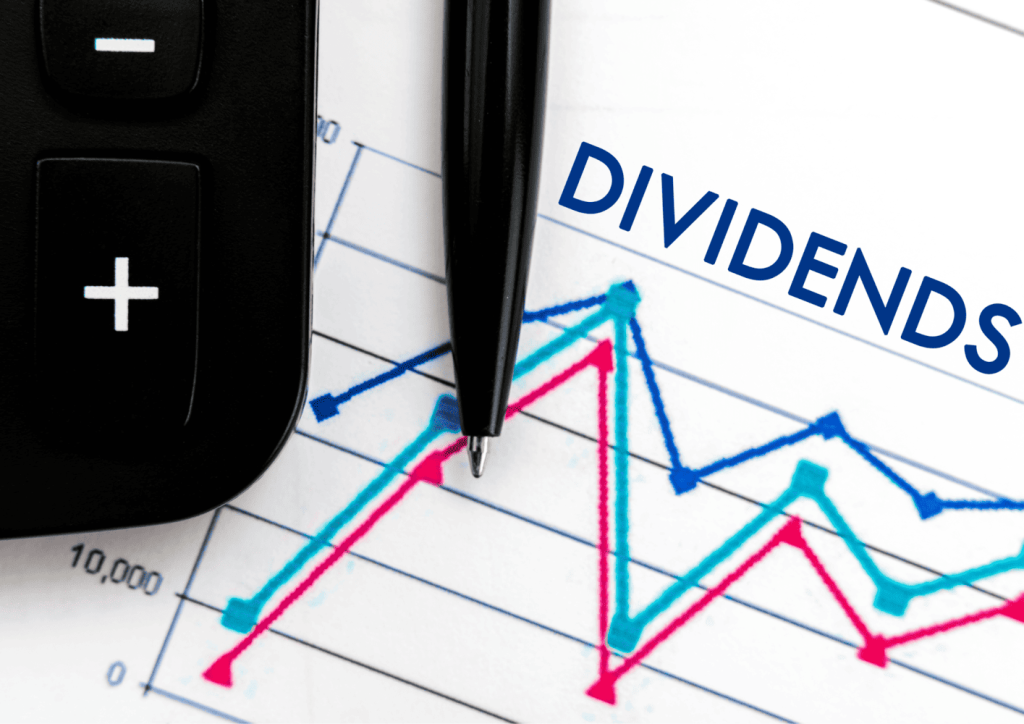Dividend investing is a strategy for those seeking financial resilience and regular returns. This approach entails acquiring dividend-paying stocks, which reward investors with payouts from the company’s profits, offering an alternative to the uncertainties of capital gains. It’s a commitment to steady income, where each dividend payment mirrors the company’s fiscal health and the investor’s prudence.
Dividends stand as a testament to a company’s success and its shared prosperity with shareholders. For investors, dividend income provides a counterbalance to market fluctuations, securing a portion of profit that extends beyond the potential stock price appreciation. The pursuit here is one of not just high returns but consistent ones, fitting for anyone from the retiree to the novice investor, each aiming to adapt dividend investing to their personal financial storyline.
Venturing into dividend investing involves more than a pursuit for high dividend yields; it requires a refined grasp of dividend payout ratios, the pivotal timing of the ex-dividend date, and the robustness of the company’s free cash flow. Armed with insight and discretion, this pathway can enhance one’s investment returns while instilling a layer of fiscal serenity into their investment approach.
The Appeal of Dividend Stocks

Dividend stocks stand out in the investment landscape as beacons of consistency. Traditionally associated with well-established, financially robust companies, they offer more than just a share of ownership—they provide investors with a regular share of the company’s profits. The allure of these stocks lies in their track record of paying dividends, often viewed as a reflection of a company’s enduring financial health and a commitment to shareholder value.
Investors gravitate towards dividend stocks for their potential to deliver a steady income stream. This characteristic is especially appealing for those seeking to complement their earnings or shore up their portfolios against the headwinds of market volatility. The consistency of dividend payments can act as a cushion during economic downturns when stock prices may falter, providing a tangible return that can help to stabilize overall investment returns.
Furthermore, dividend investing isn’t merely about the immediate cash dividend; it’s about the prospect of benefitting from a dividend growth strategy. Many companies aim to increase their dividend payouts over time, which can lead to a rising income stream and potential for compound growth, especially when dividends are reinvested. This aspect of dividend investing can be particularly compelling for long-term investors looking to build wealth steadily while also enjoying the “fruits” of their investments in the form of regular dividend income.
Also Read: What is Buffet’s Strategy on Dividend
Assessing Dividend Yield
In the field of dividend investing, the dividend yield stands as a critical metric. It is the ratio that investors use to gauge the return on a dividend stock, calculated by dividing the annual dividend payments by the stock’s current market price. The yield serves as a snapshot of the income you might expect relative to the price of the investment, making it a fundamental aspect for evaluating dividend stocks.
While a high dividend yield may seem immediately attractive, it warrants a closer examination. It could be a sign of a rewarding investment, where a company is committed to returning substantial profits to its shareholders. However, an elevated yield could also be a red flag—a distress signal indicating that the company’s stock price is in a downward spiral while dividend payouts remain temporarily unchanged. In such cases, what appears to be a lucrative yield may actually suggest underlying financial troubles or a market apprehension about the company’s future prospects.
Therefore, when assessing a dividend yield, it’s imperative to consider the reasons behind its level. Investors should investigate whether a high yield is due to a company’s strong performance and robust free cash flow, which sustains and potentially increases dividend payments, or if it’s the result of a recent drop in the stock price, reflecting potential distress. Balancing yield analysis with an evaluation of the company’s overall financial health and market conditions is key to making an informed dividend investing decision.
The Strategy Behind Dividend Investing

Dividend investing requires a strategic approach, one that involves a thorough analysis beyond surface-level indicators. It starts with evaluating the company’s dividend yield, which, while informative, is just one piece of the puzzle. An investor must assess the sustainability of dividend payouts over the long term. This evaluation helps ensure that the income generated aligns with the investor’s financial goals, particularly for those relying on this income for a significant part of their investment strategy.
The payout ratio is another indispensable tool in the dividend investor’s kit. This ratio, which measures the proportion of earnings paid out as dividends to shareholders, provides insight into a company’s ability to maintain its dividend payments. A high payout ratio might indicate that a company is returning most of its earnings to shareholders, which could be unsustainable in the long run. In contrast, a moderate payout ratio may suggest that the company has ample room to grow its dividends or reinvest in its own operations, potentially leading to higher stock prices and yields in the future.
Crafting a dividend investing strategy also involves looking at the broader picture, including the company’s earnings growth, historical dividend trends, and its economic moat. Stability and consistency in paying dividends can be a sign of a company’s financial health and management’s confidence in future cash flows. Moreover, investors might seek out dividend aristocrats—companies with a history of increasing dividends over time—as they can be particularly attractive for dividend growth strategies. By focusing on these aspects, investors can craft a dividend portfolio that not only delivers on present income but also positions them for potential capital gains and increased dividend income in the future.
Dividend Growth and Compounding
Dividend growth is the gradual increase in the annual dividend payout a company disburses, reflecting its growing earnings and commitment to shareholders’ rewards. This increment is a hallmark of financial stability and shareholder-centric policies. Dividend aristocrats, a revered group within the stock market, are companies known for their reliable dividend growth. They have a storied history of not just paying dividends but consistently boosting their payouts over a substantial period, often across multiple economic cycles.
The concept of reinvesting dividends plays a pivotal role in the art of compounding—one of the most powerful forces in investing. When investors opt to reinvest their dividends into purchasing more shares of the dividend-paying stock, they set the stage for a compounding effect. This means that over time, they not only receive dividends on their initial shares but also on the additional shares acquired through reinvestment. This strategy can lead to exponential growth of an investor’s holdings and, subsequently, their dividend income.
The potency of compounding with dividend growth cannot be overstated. As the dividend payouts increase and more shares are accumulated through reinvestment, the investor’s asset base expands, creating a positive feedback loop. This compounding effect is what can turn a modest initial investment into a considerable sum over the years, showcasing the potential of dividend investing strategies to contribute significantly to one’s financial growth and long-term wealth accumulation.
Types of Dividend-Paying Assets

When diversifying an investment portfolio, incorporating dividend-paying assets can be a strategic move to enhance income generation and reduce risk.
Beyond the allure of individual stocks, there’s a spectrum of assets that can provide investors with the benefits of dividend income. From funds that aggregate a variety of dividend stocks to trusts that focus on income from real estate, each type of dividend-paying asset offers different advantages, risk profiles, and management styles.
Individual Dividend Stocks
Investing in individual dividend stocks offers investors direct exposure to companies that pay dividends. This approach can be highly selective, allowing investors to choose companies with a strong track record of dividend payments and the potential for dividend growth. However, it requires a deeper level of research and risk tolerance, as portfolios are often less diversified than funds, making them more susceptible to market fluctuations and specific company risks.
Dividend Funds
Dividend funds are investment vehicles that pool money from many investors to purchase a portfolio of dividend-paying stocks. These funds often aim for a balance of high dividend yields and potential for stock price appreciation, seeking to provide investors with regular dividend income while minimizing risk through diversification. They are a convenient option for investors looking for a hands-off approach to dividend investing.
Mutual Funds
Mutual funds that focus on dividend stocks offer a traditional way to invest in a diversified portfolio of dividend-paying companies. They are managed by professional portfolio managers who strive to select dividend stocks that may offer both stability and growth. This type of investment allows shareholders to potentially benefit from consistent dividend payments and capital gains without having to select individual stocks themselves.
Real Estate Investment Trusts (REITs)
Real Estate Investment Trusts (REITs) are companies that own, operate, or finance income-generating real estate across a range of property sectors. They are known for paying dividends, which are typically higher than average due to tax regulations requiring them to distribute at least 90% of taxable income to shareholders. REITs provide a way to invest in real estate without owning physical property and can be an effective method to generate income.
Index Funds
Index funds that track dividend-focused indices are a form of passive investing in dividend-paying stocks. These funds mirror the performance of a dividend stock index, offering broad market exposure and inherent diversification. For investors seeking to invest in dividend stocks with lower management fees and simplicity, index funds are an attractive option, as they tend to reflect the risk and return profile of the dividend-paying market segment they track.
Timing Dividend Payments
Timing is a pivotal factor in the pursuit of dividend payments, with the ex-dividend date marking a definitive line. To secure the forthcoming dividend payment, investors must purchase the stock before this date. Once the ex-dividend date passes, the stock trades without the right to receive the most recently declared dividend. This date is critical for investors whose strategy includes timing purchases for dividend income, as ownership before the ex-dividend date is essential for inclusion on the company’s books as a shareholder of record.
The tax implications of dividends paid are not uniform; they can vary depending on the nature of the dividend. Qualified dividends, for example, benefit from lower tax rates comparable to those of long-term capital gains, but they must meet specific criteria set by the IRS, including a minimum holding period.
On the other hand, non-qualified dividends are taxed at higher ordinary income tax rates. Investors aiming to optimize their after-tax returns should consider the tax classification of dividends when planning their investment strategies, ensuring they meet the requirements to benefit from potentially lower tax rates on their dividend income.
Risks and Considerations

The appeal of dividend investing comes with its share of risks that need to be diligently assessed. One of the primary market dynamics that dividend investors should be wary of is the impact of rising interest rates. As interest rates climb, the cost of borrowing capital increases for companies, which can squeeze profit margins and reduce the free cash flow available to pay dividends. Furthermore, higher interest rates often lead to a shift in investor preference towards fixed-income securities, potentially resulting in a fall in stock prices and making dividend yields less attractive in comparison.
On the corporate front, dividend payouts are directly linked to a company’s financial health, specifically its free cash flow. If a company’s cash flow is constrained due to operational challenges or other financial commitments, it may have to reduce its dividend payments or, in some cases, suspend them entirely. Such actions can lead to a negative investor sentiment and a subsequent drop in stock prices. Therefore, it’s vital for investors to monitor not just the current dividend payout but also the overall financial stability of the company, including its free cash flow, debt levels, and future earnings potential. This scrutiny helps ensure that an investment in dividend-paying stocks is aligned with the investor’s risk tolerance and long-term financial objectives.
Conclusion
In conclusion, dividend investing stands out as a strategy that can offer regular income and the potential for capital gains. However, like any investment approach, it requires a nuanced understanding of market conditions and corporate financial health. As a professional trader, one must be astute in recognizing the interplay between dividend yields, stock prices, and rising interest rates, which can significantly influence investment outcomes. Vigilance over a company’s free cash flow and dividend payout ratio is indispensable to safeguard against the risk of reduced or discontinued dividends. The ability to discern the signs of a robust dividend paying company—one with a sustainable payout, sound financials, and a clear path to earnings growth—is paramount.
The ex-dividend date serves as a strategic beacon for dividend collection, while understanding the tax implications of qualified dividends can enhance after-tax returns. Diversification through dividend funds, mutual funds, REITs, and index funds can also mitigate individual stock volatility and sector-specific downturns. A thorough grasp of these facets enables a professional trader to navigate the dividend investing landscape adeptly, turning potential risks into opportunities and volatility into a diversified stream of income. Adopting a balanced and informed approach will continue to be the cornerstone of successful dividend investing strategies in the quest for financial growth and stability.
Also Read: What Are Defensive Stocks? A Comprehensive Guide for Investors
FAQs
What is Dividend Investing?
Dividend investing is the strategy of purchasing stocks that issue dividends — a portion of a company’s earnings paid out to shareholders. It is favored by investors seeking a regular income stream in addition to the potential for stock price appreciation. Dividends are typically paid out quarterly, but some companies may offer monthly, semi-annual, or annual dividend payments.
How does Dividend Yield affect my investment decision?
The dividend yield is a financial ratio that indicates how much a company pays out in dividends each year relative to its stock price. It is important for assessing the attractiveness of a dividend-paying stock. A high dividend yield may suggest a lucrative investment opportunity, but it could also signal a company in distress if the stock price is falling. Conversely, a low dividend yield might be a sign of a high stock price or a company retaining more earnings for growth. Investors should weigh dividend yields against other financial metrics and company fundamentals to make informed decisions.
What are the tax implications of Dividend Payments?
Dividend payments can be classified as qualified or non-qualified for tax purposes. Qualified dividends are taxed at the lower long-term capital gains rate, provided they meet certain conditions such as being paid by a U.S. corporation and held for a specific period. Non-qualified dividends are taxed at an investor’s ordinary income tax rate. Understanding the classification and tax treatment of dividends is crucial for investors to accurately assess the after-tax return on their dividend stocks.



